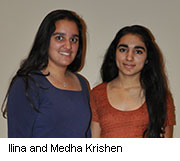October 23, 2014


Latest Lungs News
TUESDAY, Oct. 21, 2014 (HealthDay News) — Two sisters in high school have developed ways to measure lung and heart damage.
Ilina and Medha Krishen use electronic stethoscopes, which electronically amplify body sounds, to listen for sounds of trouble in breathing patterns or heartbeats.
Ilina, a senior at Port Huron Northern High School in Michigan, wanted to find a way to detect early lung damage in people exposed to harmful air pollutants. Using an electronic stethoscope, Ilina recorded one breath cycle each from 16 smokers, 25 nonsmokers and 13 firefighters.
Looking at the frequency distribution of the participants’ breath sounds, Ilina found that the number of frequency peaks above 125 Hz was much higher among smokers and firefighters, even if the firefighters were nonsmokers.
Firefighters wear breathing protection when fighting fires, but often do not wear masks when making follow-up checks of buildings after a fire is out, noted Ilina, who was to present her research next week at the American College of Chest Physicians (ACCP) annual meeting in Austin, Texas.
Research presented at meetings is considered preliminary until published in a peer-reviewed medical journal.
“The firefighters are exposed to many poisonous chemicals that remain in the air after the fire has gone out,” Ilina said in an ACCP news release. “Screening with an electronic stethoscope may be able to detect early changes in lung function in individuals without symptoms of lung disease.”
At the same meeting, younger sister Medha presented findings from a study in which she used an electronic stethoscope to screen student athletes for a heart condition called hypertrophic cardiomyopathy (thickening of the heart muscle).
The junior at Port Huron Northern High School studied 10 athletes with healthy hearts and three with hypertrophic cardiomyopathy. She recorded five seconds of heart sounds when the participants were standing, lying down and after they had exercised.
Compared to when they were lying down, athletes with healthy hearts had a lower percentage of frequency peaks above 131 Hz after exercise, while those with hypertrophic cardiomyopathy had a higher percentage of frequency peaks after exercise.
“When I was in fifth grade, a family friend died after exercise, and I always wanted to learn more about how to prevent something like that happening,” Medha said in the news release. “My study analyzing heart sound frequencies may be a useful technique that school staff could use to screen for [thickening of the heart muscle].”
— Robert Preidt
 Copyright © 2014 HealthDay. All rights reserved.
Copyright © 2014 HealthDay. All rights reserved.
SOURCE: American College of Chest Physicians, news release, Oct. 21, 2014
![]()